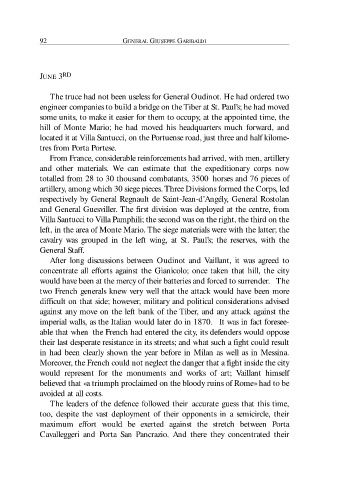Page 94 - General Giuseppe GARIBALDI - english version
P. 94
92 GENERAL GIUSEPPE GARIBALDI
JUNE 3 RD
The truce had not been useless for General Oudinot. He had ordered two
engineer companies to build a bridge on the Tiber at St. Paul’s; he had moved
some units, to make it easier for them to occupy, at the appointed time, the
hill of Monte Mario; he had moved his headquarters much forward, and
located it at Villa Santucci, on the Portuense road, just three and half kilome-
tres from Porta Portese.
From France, considerable reinforcements had arrived, with men, artillery
and other materials. We can estimate that the expeditionary corps now
totalled from 28 to 30 thousand combatants, 3500 horses and 76 pieces of
artillery, among which 30 siege pieces. Three Divisions formed the Corps, led
respectively by General Regnault de Saint-Jean-d’Angély, General Rostolan
and General Guesviller. The first division was deployed at the centre, from
Villa Santucci to Villa Pamphili; the second was on the right, the third on the
left, in the area of Monte Mario. The siege materials were with the latter; the
cavalry was grouped in the left wing, at St. Paul’s; the reserves, with the
General Staff.
After long discussions between Oudinot and Vaillant, it was agreed to
concentrate all efforts against the Gianicolo; once taken that hill, the city
would have been at the mercy of their batteries and forced to surrender. The
two French generals knew very well that the attack would have been more
difficult on that side; however, military and political considerations advised
against any move on the left bank of the Tiber, and any attack against the
imperial walls, as the Italian would later do in 1870. It was in fact foresee-
able that when the French had entered the city, its defenders would oppose
their last desperate resistance in its streets; and what such a fight could result
in had been clearly shown the year before in Milan as well as in Messina.
Moreover, the French could not neglect the danger that a fight inside the city
would represent for the monuments and works of art; Vaillant himself
believed that «a triumph proclaimed on the bloody ruins of Rome» had to be
avoided at all costs.
The leaders of the defence followed their accurate guess that this time,
too, despite the vast deployment of their opponents in a semicircle, their
maximum effort would be exerted against the stretch between Porta
Cavalleggeri and Porta San Pancrazio. And there they concentrated their

